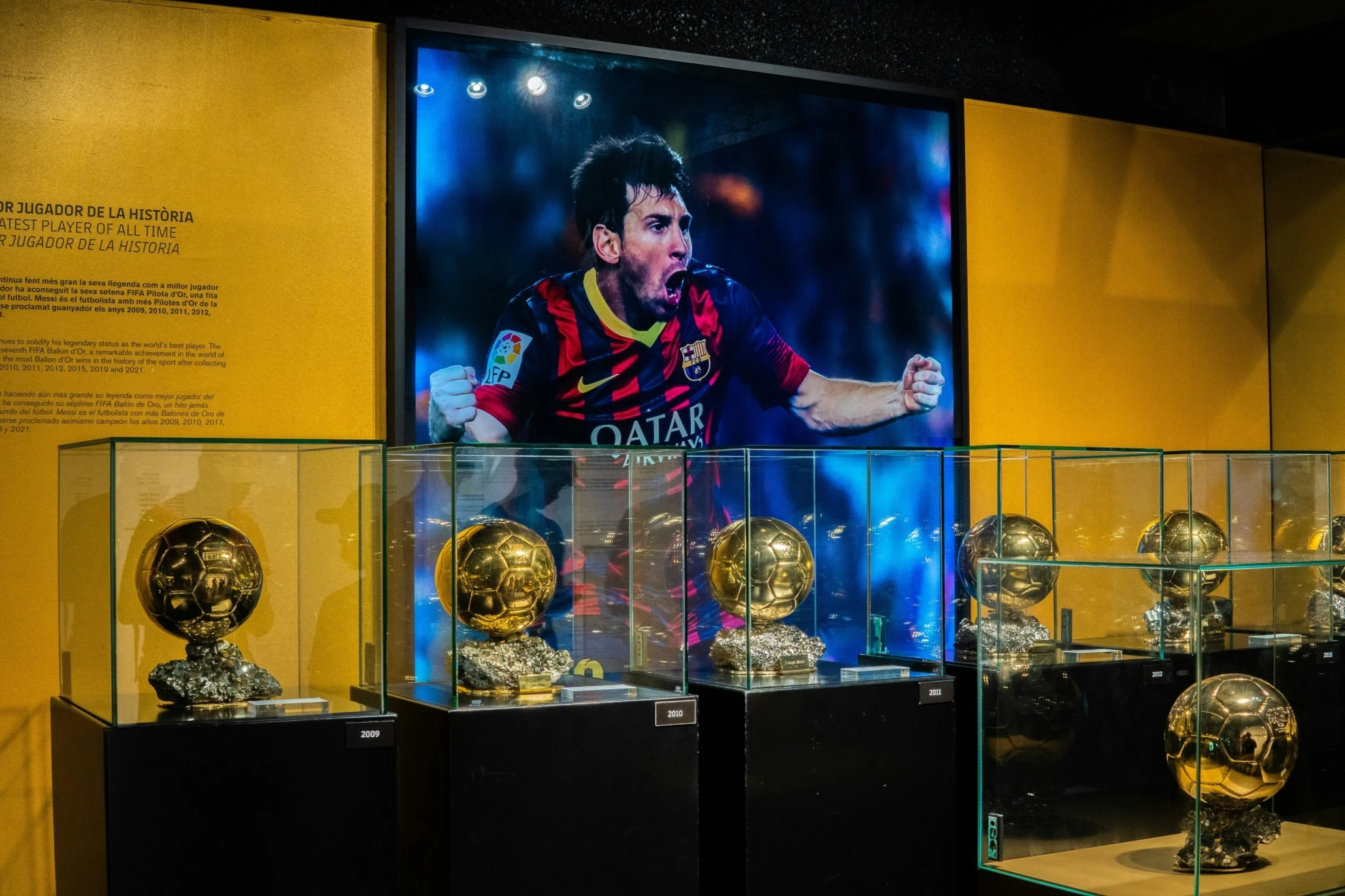Lionel Messi’s Playing Style has transitioned from a dangerous dribbler to a brilliant playmaker and scorer. From his youth at Barcelona to his international fame, Messi’s capacity to evolve and hone his craft has characterized his transformation from child prodigy to football legend.
When a 17-year-old Lionel Messi netted his first official goal for Barcelona in May 2005, not many could have anticipated the uncharted path that would unfold. More than two decades on, Lionel Messi’s Playing Style remains arguably the most analyzed, revered, and influential in the history of football. What is most intriguing about his development isn’t merely the success attained, but how intentionally his game has been reshaped—adjusting to physical modifications, tactical imperatives, and the inexorable passage of time.
“What distinguishes Messi from nearly everybody else is his ability to reinvent himself,” opines Pep Guardiola, the boss who guided Messi through his formative years. “He interprets the game so well that he’s always three steps ahead in designing his own development.”
This incessant transformation hasn’t been happenstance but instead a masterclass in sporting evolution. Through the analysis of the clear stages of Messi’s playing style development, we learn about not only an incredible sportsman, but maybe the sport’s best problem-solver.
The Explosive Winger (2004-2009): Speed and Spontaneity
Messi’s early development revealed a player whose chief arsenal was explosive acceleration and near-supernatural capability to hold onto the ball at top speed. At this nascent stage, his style of play was built around raw, instinctive ability more than tactical finesse.
Frank Rijkaard, who gave Messi his Barcelona debut, observed: “Even as a teenager, he possessed this rare combination of extraordinary speed with perfect technical control. Most players sacrifice one for the other—they’re either fast or technically precise. Leo somehow maximized both simultaneously.”
Key characteristics of early Messi included:
- Electric acceleration over short distances
- High-volume dribbling attempts (often 15+ per match)
- Preference for operating in wide areas
- Relatively limited defensive contribution
- Finishing primarily right-footed
These years cemented Messi as a prodigy, but tactical discipline was not yet his defining feature. He was used mainly as a classic right winger in Rijkaard’s 4-3-3, told to beat his opponent and make space instead of being part of intricate positional sets.
The facts speak of a player still searching for his identity:
| Season | Goals | Assists | Dribbles Per Game | Main Position |
|---|---|---|---|---|
| 2005/06 | 8 | 5 | 3.5 | Right Wing |
| 2006/07 | 17 | 4 | 5.2 | Right Wing |
| 2007/08 | 16 | 13 | 5.8 | Right Wing |
| 2008/09 | 38 | 18 | 4.6 | Right Wing/False 9 |
This first phase reached its climax in the 2008/09 season, with Guardiola‘s arrival introducing Messi towards a more central role. The iconic “false nine” experiment in the 2-6 Clásico win over Real Madrid in May 2009 marked the death of Messi the winger and the birth of something revolutionary.
The False Nine Revolution (2009-2014): Central Dominance Messi’s New Playing Style
Under Guardiola, Lionel Messi playing style saw its most extreme change. By playing centrally as a “false nine,” he became the gravitational force at the center of one of the all-time great club teams. It required new skills and awareness.
“We had to get Leo more integrated into our build-up play,” Guardiola said. “By playing him centrally but dropping deep, he could link midfield and attack while freeing our wide players to attack. Defenders didn’t know whether to go with him deep or stay up.”
This period witnessed Messi become a finished attacking force:
- Much better playmaking from central positions
- Evolution of his left-foot finishing into a trademark asset
- Dominance in creating space via positional awareness
- Improved tactical knowledge and familiarity with patterns
- Refining the “Messi dribble” – close control at intermediate pace with body tricks
This era saw arguably the best single season in footballing history (2011/12), when Messi netted an incredible 73 goals in 60 games across all competitions. His style of play during this era was the ultimate blend of individual genius within a team system.
Sports scientist Simon Brundish observes: “What was so incredible about mid-career Messi was his movement efficiency. Other players may run 12-13km per game, but Messi averaged a little under 7.6km but with much greater impact. He had mastered the art of being still, saving his energy for explosive movements when the chances came.”
The Playmaker Emerges (2014–2019): Lionel Messi’s Playing as the Deep-Lying Creator
As Barcelona’s team makeup shifted and Messi entered his late twenties, another transformation took place. With Luis Suárez taking central striking roles and Neymar offering explosive wide play, Messi slowly pulled deeper into midfield, becoming perhaps football’s greatest playmaker.
“From around 2015, we were getting a different Messi,” says tactical analyst Michael Cox. “He was less self-interested about scoring himself and more intent on being the conductor of the offense. His passing range improved spectacularly, especially those diagonal switches to Alba and those perfectly weighted through-balls over defenses.”
This period witnessed some crucial developments:
- Decreased defensive press intensity
- Mastery of the “pause” – slowing down play before accelerating
- Creation of an elite-level passing repertoire over distance
- Increased participation in build-up play from midfield positions
- More strategic conservation of energy for pivotal moments
What made this transformation so great was the way Messi accepted efficiency as opposed to spectacle. Where before he would attempt 10-12 dribbles per game, he now selected his moments more sparingly, concentrating instead on ruthless passing that disrupted defensive structures.
Barcelona’s slow tactical fall during this era also required more solo problem-solving from Messi. As team systems became less unified under consecutive managers, his playing style adjusted to make up for it, becoming more responsible for creating as well as finishing.
The Veteran Maestro (2019–Present): Lionel Messi’s Playing Style Becomes Economical Brilliance
The latest iteration of Messi’s game is the victory of brains over brawn. Now firmly in his thirties, Messi has become football’s greatest economical mastermind—making maximum impact with minimal unnecessary movement.
“What we’re witnessing today is absolute football intelligence,” says former Argentina teammate Juan Sebastián Verón. “He knows precisely when to speed up and when to bide his time. His decision-making comes quicker than anybody else’s, and that makes up for any loss of physical abilities.”
The modern Messi practices:
- Much less pressing and defensive labor
- More emphasis on “scanning” – incessant head movement in order to chart the field
- More concentration on set-piece mastery
- Master-level passing prioritizing ball movement
- In-game strategic “rest periods” to conserve energy
This period has coincided with difficult team environments—later Barcelona years, the transition to Paris Saint-Germain, and finally his transfer to Inter Miami—demanding Messi to be even more autonomous. His Copa America victory with Argentina in 2021 exemplified this mature playing style to perfection: controlled, frugal, and ruthlessly efficient when moving into action.
Sports physiotherapist Richard Blagrove says: “Messi’s latter career adjustment is a masterclass in the management of physical resources. He’s minimized high-intensity sprinting by around 40% since his peak years, but sustained his efficacy by optimizing his positional awareness and decision speed.”
Key Influences On Lionel Messi‘s Evolving Playing Style
A number of factors have contributed to Messi’s stylistic evolution:
Tactical Influences
Various managers have highlighted various parts of Messi’s game:
- Rijkaard: Promoted expressive dribbling and personal creativity
- Guardiola: Incorporated Messi’s brilliance into positional frameworks
- Luis Enrique: Established a system for Messi to link with top-class forward partners
- Scaloni (Argentina): Constructed the national team system around Messi’s individual requirements
Physical Adaptations
Messi’s playing style has developed in part as a reaction to his own physical development:
- Early growth hormone treatment affected his low center of gravity
- Chronic hamstring problems (2013-2014) compelled less high-intensity running
- Adjustment to the aging process by increased movement efficiency
- Nutritional adjustments in 2014 (removing sugar and decreasing meat) contributed to longevity
Technical Development
Messi has continued to develop certain technical aspects:
- Increasingly superior left-footed finishing technique
- Building free-kick skill in his late twenties
- Transition from largely short passing to overall passing range
- Tuning of “La Pausa” – the brief pause that unsettles defenders
The Statistical Evolution
The statistics paint a compelling picture of Messi’s evolution:
| Career Phase | Goals per Game | Assists per Game | Dribbles per Game | Passes per Game |
|---|---|---|---|---|
| Winger (2004-09) | 0.48 | 0.25 | 5.4 | 29.3 |
| False Nine (2009-14) | 1.12 | 0.42 | 4.8 | 47.1 |
| Deep Creator (2014-19) | 0.82 | 0.51 | 4.2 | 65.7 |
| Veteran (2019-Present) | 0.64 | 0.47 | 3.6 | 62.4 |
These figures illustrate how Messi’s role has evolved—from a mostly scoring-oriented winger to a more central playmaker who balances creation and finishing.
Conclusion: Lionel Messi The Ultimate Football Adapter
What makes Lionel Messi’s playing style truly remarkable isn’t just its excellence but its evolutionary nature. Unlike many greats who perfect a singular approach, Messi has continuously reinvented himself—adapting to physical changes, tactical demands, and team needs throughout his career.
The teen once bullied defenders remorselessly with dazzling dribbling has developed into football’s maestro conductor, able to dominate games with movement, passing, and timed accelerations to a finish. There have been different strengths in each stage of his career but the same underlying genius: an unmatched real-time problem-solving skill in football.
Maybe Messi’s greatest legacy is not any one achievement but this incredible ability for evolution—a model for how excellence can be maintained not through dogged consistency but through smart adaptation. As his career nears its closing chapters, Messi’s style of play is football’s greatest example of evolution in the pursuit of greatness.
What element of Messi’s playing style transformation impresses you the most? His explosive early dribbling, his false-nine goal-scoring, his playmaking genius, or his efficiency in his latter career years? Let us know in the comments below or check out our football tactics discussion community to see more player evolution studies!
A dedicated tactical analyst with over 10 years of experience studying European football’s elite leagues. Imran follows the Premier League, La Liga, Serie A, and Bundesliga with particular focus on managerial systems and tactical evolution. Watching 2-3 matches weekly across these competitions, he has developed deep insights into how different coaching philosophies translate across leagues and cultures. At Latest in Football, Imran specializes in breaking down complex tactical decisions and managerial appointments for everyday football fans.




